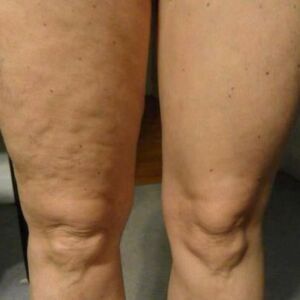What should first be done before considering TS-GS?
Before the procedure, your ASDS physician will review your medical history and perform a physical examination. This is the time for the doctor and patient to discuss expectations, potential risks, and outcomes of the procedure.Cellfina
In addition, the patient should:
- be in healthy condition.
- have realistic expectations.
- report any history of allergic reaction to anesthesia.
- tell the doctor about any prescription and over-the-counter medication, as well as supplements that they are currently taking.
- avoid shaving the treatment area prior to surgery.
- not take blood-thinning drugs for at least two weeks prior to surgery.
- avoid smoking for at least two months prior to surgery.
What is Tissue Stabilized-Guided Subscision (TS-GS)?
Cellulite is described as dimpling of the skin on the buttocks, thighs, and abdomen and occurs in 85% of women over the age of 21. Areas of skin affected by cellulite have thick, collagen bands oriented vertical to the skin called “septae”. Septae pull down on the skin surface, which makes the skin and underlying fatty tissue appear dimpled.
Tissue Stabilized-Guided Subscision (TS-GS) is commercially known as Cellfina and is a minimally invasive, FDA-cleared device used for improving the appearance of cellulite dimples on the buttocks and thighs. TS-GS is performed in a single treatment session.
Prior to the procedure, your ASDS physician will mark the cellulite dimples that may be improved with TS-GS. Then a dilute numbing fluid, called tumescent solution, is injected into the skin and underlying fatty tissue to keep the patient comfortable during and after the procedure. Next, the TS-GS device is applied to the cellulite dimple. With the use of suction, the cellulite dimple is pulled inside of the device to stabilize the skin tissue. A specialized handpiece is then used to release the cellulite dimple as a precisely selected depth. TS-GS is continued until all of the dimples selected for treatment have been released.
What are the complications or potential side effects of TS-GS?
Common side effects include:
- Swelling
- Bruising
- Bleeding
- Hardness
- Numbness
- Soreness
- Redness
Uncommon side effects include:
- Allergic, toxic, or other reactions to lidocaine or epinephrine
- Infections
- Inflammatory reactions
- Hematomas
- Seromas
- Scars
- Skin necrosis
- Pigmentation changes
- Contour irregularities
Where is TS-GS appropriate?
TS-GS can be used to treat:
- cellulite dimples on the buttocks
- cellulite dimples on the mid to upper thighs
Who is not a candidate for TS-GS?
TS-GS is not recommended for patients who:
- have a current infection in the treatment area
- have diabetes
- have excessive obesity
- have uncontrolled diabetes
- have active cancer
- have blood-clotting problems
- have an allergy to lidocaine or epinephrine
- have varicose veins or significant vein disease in the treatment area
- are pregnant
Is TS-GS painful?
A dilute anesthetic mixture called tumescent solution is injected prior to your procedure to keep the patient comfortable during and after the procedure. Before and following treatment, compression garments can be used to decrease swelling. Over the counter pain reducers, such as acetaminophen, can be taken to improve comfort in the recovery period.
What can I expect after having had TS-GS?
Patients will experience swelling after their procedure. The most noticeable swelling can last from 5-14 days, but small areas of swelling may persist for 4-6 weeks. Bruising is common and may take 2-3 weeks to fully resolve. Many patients will feel like resuming their normal activities in 1-2 days along with a return to a light exercise regimen within a week. Patients often begin to notice lessening of their cellulite dimples in a month and this continues to improve over time. The improvement in the appearance of cellulite can last at least two years.
FAQ
Is Cellfina permanent?
The end result is smooth skin that lasts for at least two-three years and perhaps considerably longer based on long term follow up of the earliest studies. Studies showed that 93% of Cellfina patients were happy two years after their treatment. ... However, most patients never need a second Cellfina treatment.
Does Cellfina work on front of thighs?
This procedure is ideal for skin dimpling on the buttocks or upper backs of the thighs. I find that it is not as effective for the front of the thighs or the area above the knees.
Does Cellfina work on cellulite?
According to a prospective, multicenter U.S. study of 55 patients, one Cellfina treatment improved the appearance of cellulite in 98 percent of people two years after they had the procedure.

